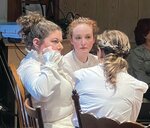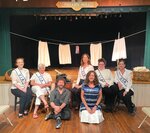


Just another home-grown show? Not at all.
It was an old story that’s been told and retold — the founding of Doylestown Hospital by the VIA, the Village Improvement Association, a women’s club, a hundred years ago.
Carefully crafted, imaginatively presented, “Voices” was a pleasure to watch at the Phillips’ Mill in July.
Joy Nash, an architect, novelist and Doylestown resident, told the hospital’s history through minutes of the club’s meetings. Nash introduced the show, describing her discovery of the early minutes, almost as if she had just casually come upon them and pulled out a bit of information.
But her input was more than that. She read accounts in W.W.H. Davis’ History of Bucks County (only 19 women’s names were mentioned), Helen Gemmill’s E.L., The Bread Box Papers: A biography of Elizabeth Chapman Lawrence, and Anne “Cookie” Biggs’ Through Their Eyes. And she heard the founders come to life in the VIA’s early minutes.
As she got to know the founders, Nash said, “The play kind of wrote itself.
“I was so struck by these ladies. They started a business, made a profit every year and invested the money, hired employees — quite a thing, all this stuff going on.”
The first meeting was April 26, 1895, when Isabella (Mrs. Richard) Watson gathered a small group in her North Main Street home to discuss the problem of dust from Doylestown’s unpaved streets. VIA members portrayed the “founding mothers.”
“Something must be done!” the women agreed. They formed an organization, and emphasized that it was not a social club. It was a time when women’s clubs were forming across the country.
The women asked the borough council to purchase a street sweeper. The town, they said, needed a trash collector and greenery planted, and flowers at the Civil War monument. And the spittoons should not be emptied in the middle of Court Street. The women were turned away more than once. “Women should be home with children,” one councilman told them.
The resourceful women held a town fair and raised $456 for a sweeper. But they needed a source for water — again, the borough council said “no”; it would not provide water. Mrs. Watson, the first president, told the women, “Use whatever influence you may have to bring our men around.” And the tactic worked — the council agreed to sell public water to the women’s club.
Nash and director Griffin Horn staged a thoroughly engaging play. Chairs in the small mill theater were set up perpendicular to the stage, with an aisle down the middle of the floor. Five actors dressed in white played 14 characters, mainly the founding mothers, who walked back and forth and across the floor, constantly changing places, stopping occasionally to relate what was written in the minutes. They used clotheslines and quilts as props, and soft piano music introduced them. The women engaged the audience to cheer them on.
In 1915, Sarah James and her sister, Martha (Mrs. George H.) Lorah purchased an ambulance and donated it to the borough. In 1918, the VIA hired a Red Cross community nurse, not without hiring setbacks, in time to tackle the Spanish flu as war was raging in Europe. Doylestown, the women boasted, because of the nurse and an assistant they hired, had only seven deaths in that epidemic and half of them were in Perkasie, when thousands were dying in Philadelphia.
The nurse, Miss Norma Muncy from Massachusetts, declared that she answered a newspaper ad when she saw that she would not have to answer to a single man.
By 1922, the VIA knew that Doylestown needed a hospital. It bought the former Livezey house at Pine Street and Oakland Avenue for $6,000, half paid from savings, half as a mortgage. The building had 14 beds, eight cribs and a delivery room.
In 1934, the women purchased land and, in 1929, opened the Doylestown Emergency Hospital at Belmont Avenue and Spruce Street. Isaiah Kauffman, a former patient, bequeathed his fortune to build that hospital.
In 1947, Sarah James gave the VIA the James family home on North Main Street with all its furnishings, to be open to the public for all but religious services and when she died, she bequeathed the major part of her estate to the VIA.
In 1971, the VIA held its inaugural Designer House to raise funds for the hospital and in 1973, a 200,000-square-foot hospital opened on a 50-acre property near the new Route 611 Bypass.
In 1982, the VIA supported creation of a day care center for children of employees, one of the first in the country.
In 1986, because of legal considerations in the health care industry, the founding VIA Hospital Committee disbanded. But the word from the stage was, “The VIA oversees the entire ... entire, multi-corporate Doylestown Health system.” It’s still governed by a women’s organization, which is unique in the country.
Narrator Caitlin McClean, ended the play quoting anthropologist Margaret Mead, who graduated from Doylestown High School in 1918, during the flu epidemic. Living on Court Street, McClean said, “She could not have failed to notice the visiting nurses pedaling to and fro from their many home visits.”
The often quoted Margaret Mead said, “Never doubt that a small group of thoughtful citizens can change the world.”
Some of the people who got behind the “Voices” project were Valerie Eastburn, chair of the Phillips’ Mill Drama Committee, Laurie Schutt, a member of the VIA board, and Helen Hammes, VIA president. Thomas Brunt produced a video of the drama and Joao Neves was technical consultant.
Members of the cast were Monica Mosley, Alex Lucy, Kim Cicconi and Sallyanne Donovan.
Join our readers whose generous donations are making it possible for you to read our news coverage. Help keep local journalism alive and our community strong. Donate today.